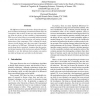Free Online Productivity Tools
i2Speak
i2Symbol
i2OCR
iTex2Img
iWeb2Print
iWeb2Shot
i2Type
iPdf2Split
iPdf2Merge
i2Bopomofo
i2Arabic
i2Style
i2Image
i2PDF
iLatex2Rtf
Sci2ools
87
Voted
EH
2000
IEEE
2000
IEEE
Evolutionary Design of Single Electron Systems
The differences between electronics design through artificial evolution and through conventional methods have the consequence that evolved circuits may take unusual leverage from the physics of their medium of implementation. This can occur even if there is no tractable analytical model to predict how the overall behaviour will emerge from the interactions of the components. This is alluring for singleelectron circuit design, and a first case-study is presented: the evolution of a NOR gate. Although the results to date are far from ideal or practical, it appears that the particular thermal energies of the electrons are exploited. Whether desirable or not, this indicates that evolution can explore new kinds of designs not seen before in the literature.
Artificial Evolution | EH 2000 | Hardware | Particular Thermal Energies | Tractable Analytical Model |
Related Content
| Added | 24 Aug 2010 |
| Updated | 24 Aug 2010 |
| Type | Conference |
| Year | 2000 |
| Where | EH |
| Authors | Adrian Thompson, Christoph Wasshuber |
Comments (0)

